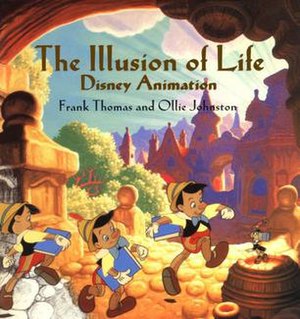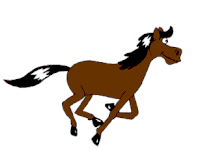 |
| Cover of The Illusion of Disney Animation |
The main purpose of these principles was to produce an illusion of characters complying with the basic laws of physics, however they also focus on emotional timing and character appeal.
The book and its principles have become adopted, and have been referred to as the "Bible of animation". In 1999 the book was voted number one of the best animation books of all time.
The 12 principles:
1. Squash and Stretch
- This action gives the illusion of weight and volume to a character as it moves.
- It is useful when animating dialogue and facial expressions - the extremity of squash and stretch depends on what is being animated in the scene.
- Making a figure squashed or stretched to an exaggerated degree can portray a comical theme.
- Squash and Stretch is used in all forms of character animation, from bouncing a ball (Shown in example A) to the body weight of a person walking.
 |
| Picture A shows a ball bouncing with a rigid, non-dynamic movement. However, Picture B shows the ball being squashed at impact, and stretched during fall and the rebound. This is a basic example of Squash and Stretch |
2. Anticipation
- Anticipation prepares the audience for a major action the character is about to perform, for example: starting to run, throw an object (Shown in Example B) or change expression. A dancer does not just leap off the floor, they have to bend their knees first - this is another example.
- This technique helps to make the action look more realistic.
- The technique can also be used for less physical actions, such as a character looking off-screen to anticipate someone's arrival, or attention focusing on an object that a character is about to pick up.
 |
| A baseball player making a pitch prepares for the action by moving his arm back |
3. Staging
- A pose or action should clearly portray to the audience the attitude, mood, reaction or idea of the character as it relates to the story and helps the narrative to progress.
- This principle can be conveyed by various means, such as the placement of a character in the frame, the use of light and shadow, and the angle / position of the camera.
- The essence of this principle is keeping focus on what is relevant, and avoiding unnecessary detail.
4. Straight Ahead Action and Pose to Pose
- Straight ahead action means drawing out a scene frame by frame from beginning to end - You can lose size, volume, and proportions with this method, but can create a more dynamic illusion of movement, and is best for creating realistic action scenes.
- Pose to pose involves starting with drawing a few key frames, and then filling in the intervals later - Size, volumes, and proportions are controlled better this way.
- Pose to pose works better for dramatic or emotional scenes, where composition and relation to the surroundings are of greater importance.
- A combination of the two techniques is often used.
5. Follow through and overlapping action
(See Example C)
- It is a general heading for two closely related techniques which help make movement more realistic.
- Follow through means that separate parts of a body will continue moving after the character has stopped.
- Overlapping action is the tendency for parts of the body to move at different rates (e.g. an arm will move on different timing of the head). (See Example C)
- Another technique is drag , where a character starts to move and parts of his body take a few frames to catch up. This can be used to animate objects like clothing or someones hair.
- Exaggerated use of the technique can produce a comical effect.
- Timing is essential to get a realistic and convincing result.
 |
| As the horse runs, its mane and tail follow the movement of the body. |
6. Slow in and slow out
- Fewer drawings make the action faster and more drawings make the action slower. Slow-ins and slow-outs soften the action, making it more life-like.
- This principle goes for characters moving between two extreme poses, such as sitting down and standing up, but also for inanimate, moving objects, like the bouncing ball in the above illustration.
7. Arcs
- All actions, with few exceptions (such as the animation of a mechanical device), follow an arc or slightly circular path. This is especially the case of the human figure or actions of animals.
- Arcs give animation a more natural action and better flow.
- All arm movement, head turns and even eye movements are fulfilled on arcs.
8. Secondary Action
- Adding secondary actions to the main action gives a scene more life, and can help to support the main action.
- The important thing about secondary actions is that they emphasize, rather than take attention away from, the main action.
9. Timing
- Timing refers to the number of frames for a given action, which relates to the speed of the action on film.
- Timing is critical for establishing a character's mood, emotion, and reaction.
10. Exaggeration
- Is keeping everything to true reality, just presenting it in a wilder and more extreme form.
- The level of exaggeration depends on whether you want realism or you are aiming for a particular style.
- You should watch the level of exaggeration used as some elements could become confusing to the viewer.
11. Solid Drawing
- When drawing for an animation, you must remember three dimensional space, which allows an object to have volume and weight.
- Three dimensional is movement in space. The fourth dimension is movement in time.
12. Appeal
- Every character has to have appeal whether they are heroic, villainous, comic or cute. Appeal is important as it has to make the audience feel that the character is real or interesting.
- Appeal includes an easy to read design, clear drawing, and personality development that will capture and involve the audience's interest.
No comments:
Post a Comment